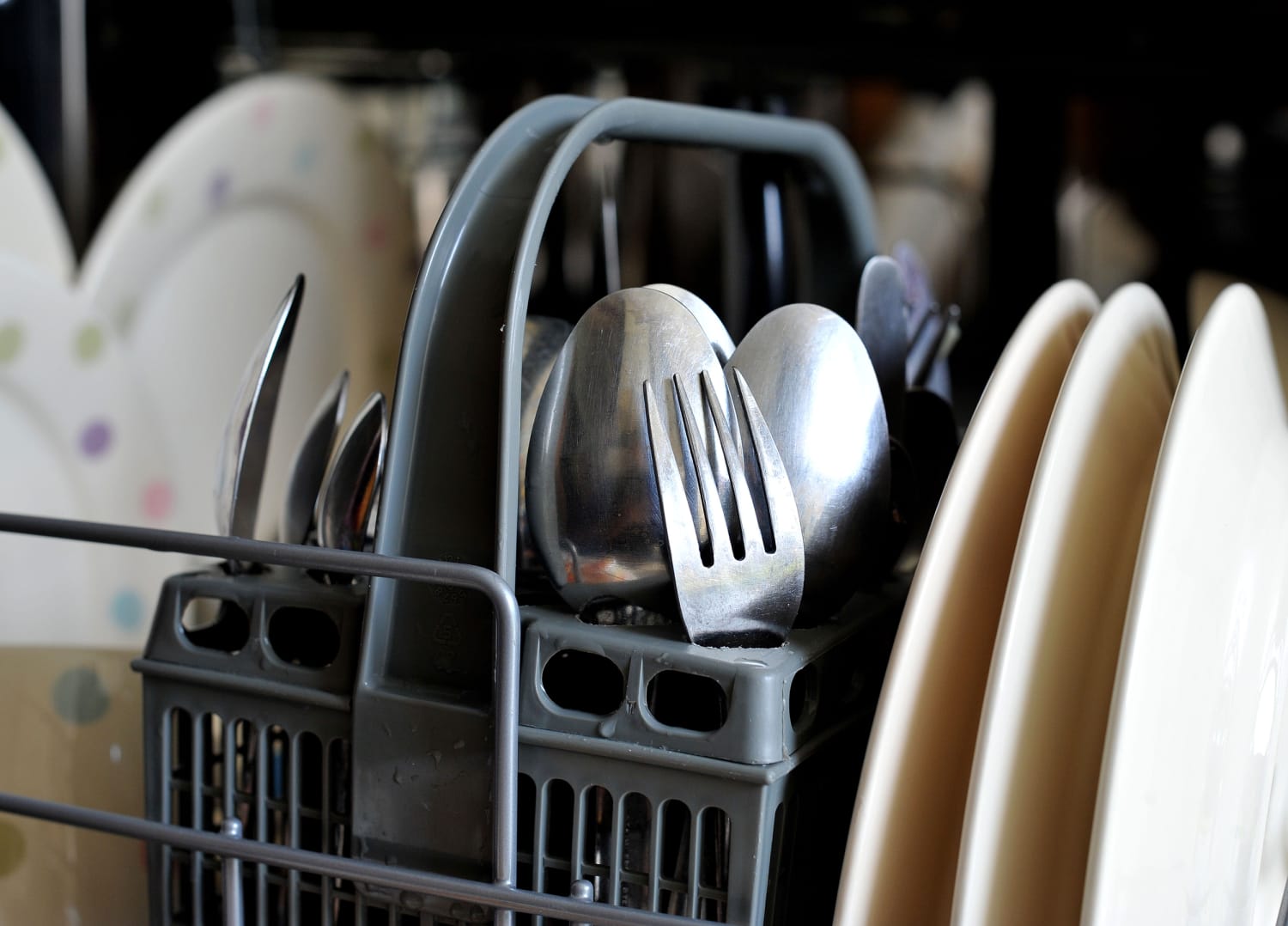Silverware should typically be loaded with the handles down for effective cleaning. However, sharp knives should be loaded with handles up for safety.
Ensuring your silverware is properly placed in the dishwasher is crucial for both cleanliness and safety. The dishwasher is a modern convenience that saves time and effort in kitchen clean-up, but knowing the correct method of loading can make a significant difference in the results.
Positioning your utensils the right way ensures that water and detergent circulate effectively, reaching every nook and cranny. With an optimized loading technique, you not only achieve a better clean but also protect your silverware from damage and prevent injury from sharp edges. Proper dishwasher loading is a small but impactful step toward maintaining your kitchen’s efficiency and your silverware’s longevity.
Table of Contents
The Great Silverware Debate
Should silverware face up or down in the dishwasher? This question has sparked countless household debates. It’s about efficiency and hygiene. Both camps have compelling arguments. Let’s explore the controversy and historical etiquette to settle this once and for all. Your cutlery could hang in the balance!
Facing Up Vs. Facing Down: The Controversy
Loading silverware facing up is said to clean better. Handles down means water reaches the business end. But is it safe? Sharp knives pose a risk. Spoons and forks facing down might not clean as well. Germs from hands may transfer to surfaces that go in our mouths.
- Cleaner Wash: Water access is better on the eating end.
- Safety First: Avoid injuries by pointing sharp edges down.
- Hygiene Concerns: Hand germs could contaminate eating surfaces.
Historical Perspectives On Dishwasher Etiquette
Historical dishwasher etiquette gives us a clue. Original dishwashers had different designs. Silverware baskets were rare. Many people put utensils in however they fit. Through time, designs evolved. Baskets became standard, sparking the debate. Traditionalists may argue for faces up, citing older manuals.
Time Period | Design | Common Practice |
|---|---|---|
Early Days | No Baskets | Random Placement |
Evolution of Baskets | Baskets Included | Debate Begins |
Safety First: Handling Silverware
When loading silverware in the dishwasher, safety takes the lead. It’s vital to protect everyone in the household, especially children who might help with chores. Proper placement of utensils can prevent accidents. Keep these tips in mind to ensure a safe kitchen environment.
Minimizing Injury Risks With Pointed Utensils
Sharp items pose a threat if not handled with care. Knives and forks, especially, can cause painful injuries. Follow these pointers:
- Place knives and forks with points down to avoid accidental pokes.
- Ensure handles are facing up for easy, safe grabbing.
- Separate sharp utensils from others to reduce risk of reaching into a nest of blades.
Ergonomic Considerations When Loading The Dishwasher
Comfort matters when loading and unloading dishes. Mind these ergonomic tips:
- Bend knees to prevent back strain.
- Load heavy items first to set a solid base.
- Keep frequently used utensils in front for easy access.
By following these guidelines, you’ll maintain a hurt-free kitchen and an efficient cleaning process.
Cleanliness Outcomes
No more guesswork with silverware in the dishwasher. Let’s uncover the best loading practices. These ensure your cutlery emerges sparkling. Position and water flow matter here.
Impact Of Positioning On Washing Efficiency
The way you position silverware in the dishwasher affects its cleanliness. Upside-down or handle-up? It’s crucial.
- Forks and spoons – handle down, ensuring no nesting.
- Knives – handle up for safety and effective cleaning.
- Basket or rack? Check your dishwasher design.
Upside-down loading increases water and detergent contact. Each piece gets meticulously cleaned.
Common Water Flow Patterns In Dishwashers
Every dishwasher has unique water flow. Recognize these patterns. They guide effective loading.
- Rotary arms – spray water from below.
- Top sprayers – cover from above.
- Side jets – tackle corners and edges.
Understand your machine’s mechanics. Load silverware for optimal exposure. Get the best wash every cycle.

Credit: www.nbcnews.com
Hygiene And Health Implications
Loading silverware in the dishwasher might seem simple. But the way you load affects cleanliness and health. Germs and bacteria can spread if not managed rightly. Let’s dive into the best ways to keep your silverware sanitary and safe.
Spread Of Germs
Silverware handles are touchpoints. Upside-down placement exposes handles to more germs.
- Spoons and forks stack when upside down, trapping food and bacteria.
- Water spray might not reach all surfaces, leaving germs behind.
- Bacteria from one item can transfer to another, raising contamination risk.
Knife blades down prevent injury and also reduce contamination.
Handling Concerns
Touching handles may transfer germs to hands. Upside down, your hand touches the eating end. This spreads illness-causing bacteria.
- Handle touch transfers germs from raw foods or unwashed hands.
- Illnesses spread through contaminated handles during unloading.
- Dry hands properly before unloading to avoid transfer.
Best Practices For Sanitary Silverware
For the healthiest approach, mix up your loading strategy:
Item | Direction | Reason |
|---|---|---|
Spoons & Forks | Handle up | Prevents nesting, better cleaning |
Knives | Blade down | Safety, minimizes handling of blade |
Use a detergent that eliminates bacteria. Choose a hot water cycle for best results. Always check for no residue before use.
- Inspect the cleanliness of each item.
- Run an extra rinse cycle if necessary.
- Dry silverware completely to prevent mildew.
Durability Of Utensils
The secret to long-lasting silverware might be simpler than you think. Silverware is an investment in your dining experience. To maintain its shine and structural integrity, loading it correctly in the dishwasher is vital. This strategy not only keeps utensils sparkling but also extends their life. Let’s explore how to prevent damage and reduce wear and tear during cleaning cycles.
Preventing Damage To Silverware
Keeping your silverware in top condition means handling it with care. A well-known tip is to load it upside down. This method:
- Protects the eating end from scratches and dings
- Reduces water spots for a gleaming finish after drying
- Ensures safe handling to avoid sharp edges
Loading handles up also minimizes contact with the dishwasher’s moving parts, which can cause nicks and wear over time.
How Dishwasher Layout Affects Wear And Tear
The position of silverware in the dishwasher can impact its longevity. Consider these factors:
Load Position | Impact on Silverware |
|---|---|
Handles Up | Less direct water force, reducing erosion |
Separation of Pieces | Prevents clanging and damage during the wash cycle |
Secure in Slots | Prevents items from falling and getting damaged |
Ensuring that each utensil is properly placed can prolong its pristine state.
Dishwashers with specialized silverware trays or slots are designed to minimize movement. This design choice guards against wear and maintains a polish. Utensils loosely placed might rub against others, leading to scratches. Therefore, each spoon, fork, and knife deserves a carefully chosen spot in the dishwasher for utmost care.

Credit: www.digitaltrends.com
Optimizing Dishwasher Space
Have you ever faced a jigsaw puzzle of dirty dishes, silverware, and assorted kitchen gadgets that all need to fit into the dishwasher? Fear not! Properly placing each item is essential for cleanliness and for optimizing dishwasher space. Let’s dive into this cutlery conundrum to ensure your dishwasher runs efficiently.
Maximizing Capacity For Cutlery
Setting up your cutlery for an effective wash doesn’t have to be a chore. Here are the key points for maximizing capacity:
- Spoons and forks should face down, to avoid nesting and ensure a thorough clean.
- Place knife blades facing down for safety, and to expose the handle to water flow.
- Utilize all available slots in the cutlery basket, without overcrowding, to allow water to circulate.
By organizing your silverware effectively, you can fit more items and achieve better cleaning results.
Strategic Loading For Mixed Dish Types
When dealing with different dishes, strategic loading is the name of the game. Follow these tips:
Dish Type | Loading Strategy |
|---|---|
Plates | Stack vertically, leaving a gap between each for water flow. |
Glasses and Cups | Angle these on the top rack to prevent water pooling. |
Pots and Pans | Place face down on the bottom rack and space apart. |
Plastic Containers | Secure on the top rack to avoid melting. |
Aligning your dishes to the dishwasher’s design optimizes space and makes sure each item gets a complete clean. Remember balance and accessibility for both dishes and water jets for amazing results.
The Role Of Dishwasher Design
Dishwasher design plays a crucial role in how effectively silverware gets cleaned. It’s not just about the soap and water; how you load your silverware also matters. The debate on whether to place silverware face up or face down can be resolved by understanding the specific design and features of your dishwasher.
Evaluating Different Dishwasher Models
Various dishwasher models possess unique designs impacting silverware placement. Some have spray arms located beneath the bottom rack, while others might have additional jets designed to clean from different angles.
- Bottom Spray Arm Models: Silverware should face downwards ensuring handles up for effective cleaning.
- Models with Multiple Jets: They allow flexibility with how silverware is placed.
Model Type | Recommended Silverware Placement |
|---|---|
Bottom Spray Arm | Downwards |
Multiple Jets | Flexible |
Determining your dishwasher’s design helps you maximize cleaning efficiency. Always consult the manufacturer’s manual for best practices.
Innovations In Cutlery Baskets And Racks
Recent innovations in dishwasher design include cutlery baskets and racks that enhance cleaning performance. These are engineered to hold silverware in an optimal position during the wash cycle.
- Separate Slots: Some baskets have individual slots to prevent nesting and ensure better water circulation.
- 3rd Rack Designs: Newer models feature a slim top rack for utensils, allowing them to lay flat and get evenly cleaned.
Remember, silverware placement might change based on these innovations. You need to identify any special features your dishwasher might have to determine the best loading method for your silverware.
:strip_icc()/silverwaredirection_v1-7ca82e8f467049a6953b9fc9b4879dfd.png)
Credit: www.bhg.com
Expert Opinions And Recommendations
Mastering the art of loading silverware in a dishwasher is a topic of debate. The right method can mean the difference between spotless utensils and a frustrating rewash. Experts weigh in on this surprisingly nuanced task. Let’s reveal the best practices from industry authorities.
Advice From Appliance Manufacturers
Manufacturers design dishwashers with specific instructions in mind. Their advice is foundational. Many suggest placing silverware handles down to ensure water spray reaches the dirty end. Yet, for safety and effectiveness, sharp knives point down. Some newer models come with dedicated slots for each piece of silverware, promoting individual cleaning. Always consult the manual for your specific model for the best results.
Guidance From Professional Chefs And Home Organizers
Chefs and organizers offer a practical perspective on dishwasher loading. Harmonious kitchen operations depend on efficiency and hygiene. Most professionals stand by the handle-down approach for a deeper clean. They argue that spoons and forks clean better when not nesting together. Here’s a simplified guide on their collective wisdom:
- Handles down: For most utensils to avoid nesting
- Handles up: For knives to prevent injuries
- No overcrowding: Each item needs space for water to circulate
- Pre-rinse: If food is dried or caked on
Remember, these recommendations maximize both sanitation and safety. They optimize resourceful dishwasher use; crucial in any dynamic kitchen environment.
Real-life User Experiences
Dishwasher debates are a staple in household conversations. People fiercely defend their approaches to loading silverware. Let’s dive into real experiences and widespread preferences when it comes to this everyday task.
Personal Anecdotes And Best Practices
Silverware setup in dishwashers triggers passionate discussions. Online forums and kitchen tables alike buzz with tips and testimonies. These stories often shape our own habits.
- Jane from Texas swears by positioning forks and spoons handle down to enhance cleaning.
- Mike in Ohio suggests handle up to avoid sharp edges.
- Meanwhile, Karen in Florida mixes it up for optimal space usage.
Common advice from seasoned users includes:
- Space out utensils for better water flow.
- Avoid nesting to prevent residue buildup.
- Alternate handles up and down for knives for safety.
Survey Results: Public Preferences On Silverware Placement
Recent surveys shed light on user preferences. The public speaks, and here’s what they say:
Placement | Percentage |
|---|---|
Handles up | 45% |
Handles down | 35% |
Mixed orientation | 20% |
The results highlight a slight preference for handles up. Yet, a significant number of users opt for other methods. Personal preference and safety are key factors driving these choices.
Frequently Asked Questions
Should Silverware Be Facing Up Or Down In Dishwasher?
Place silverware facing down in the dishwasher, except for knives, which should face up for safety. This ensures thorough cleaning and minimizes injury risk.
What Is The Best Way To Place Cutlery In The Dishwasher?
Place forks and spoons facing up, knives facing down for safety. Ensure utensils aren’t nested together. Spread out cutlery for effective cleaning.
Do You Put Dishes Upside Down In Dishwasher?
Yes, place dishes upside down in the dishwasher to ensure water doesn’t collect on them during the wash cycle. This helps to achieve a more effective clean and better drying.
Is There A Correct Way To Load A Dishwasher?
Yes, there is a correct way to load a dishwasher. Place larger items on the bottom rack facing the center. Ensure utensils are separated for effective cleaning. Position cups and smaller items on the top rack. Avoid overcrowding to ensure water circulation.
Check manufacturer’s recommendations for best practices.
Bottom Line
Deciding on the best orientation for silverware in the dishwasher doesn’t have to be daunting. Proper placement ensures both safety and cleanliness. Upside down or handle up, the key is consistent, clear-cut results. As we’ve explored, options vary, but effectiveness remains paramount.
So, choose the method that aligns with your dishwasher’s design and personal preferences – then enjoy sparkling silverware after every cycle.



